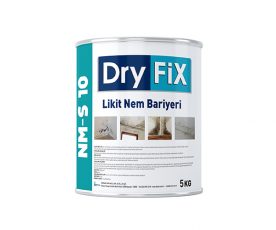
Dampness and Mold Paint
Mold-Preventive Ceiling Paint
Is moisture the same as dampness?
Moisture occurs when water molecules evaporate and spread into the environment. The more water molecules evaporate, the higher the moisture level becomes. Dampness, on the other hand, happens when a wall is continuously exposed to water or materials containing water, causing water to penetrate the wall. This leads to the growth of fungi and bacteria on the wall. It also causes structural damage to the wall. Peeling, flaking, color changes (such as black spots), and unpleasant odors spreading into the environment are common signs of dampness. Poorly ventilated spaces with high humidity increase the speed of dampness formation. Dampness can also trigger allergic diseases. Mites, fungi, and bacteria formed in the environment spread through the air and can harm the lungs when inhaled. Eliminate these problems with Dampness-Preventive Paint.
Moisture Paint
Which paint is used for dampness?
There are many ways to eliminate dampness. However, for moisture and dampness, you can use Dryfix NM-S 10, specially produced with an odorless feature superior to its counterparts. But before painting, the water interaction with the walls must be completely stopped. No matter what material you use, the problem will persist if the wall remains in contact with water.
After stopping water contact, a permanent solution can be achieved by applying DRYFIX NM-S 10, a specially formulated moisture paint with high adhesion that can be applied directly on any surface without primer or dilution.
It is written as NM-S 10 and pronounced as “NEME SON” (meaning “end to moisture”). For detailed information; Click Here Now!
How to clean damp walls?
The cleaning process depends on the condition of the damp wall. Methods such as wiping the wall with a dry cloth and scraping peeling areas with a spatula can be applied. For best results, DRYFIX NM-S 10 (Moisture and Dampness Paint) requires that peeling areas on the wall are removed.
Cleaning walls with chemical detergents alone is not enough. Dampness may recur. It is essential to provide insulation with Mold-Preventive Paint.
On which surfaces can DRYFIX NM-S 10 Mold-Preventive Paint be used?
One of the most important features of DRYFIX NM-S 10 is that it can be applied to all surfaces. You can use it on ceilings, walls, floors, painted or unpainted surfaces, plaster, gypsum, concrete, and many other parts of the structure.
Wherever you experience problems on walls or ceilings, take a photo and send it to us by clicking the WhatsApp icon.
Our expert team will answer your questions via WhatsApp.

Does Dampness-Preventive Paint really work?
Dryfix NM-S 10 Moisture Paint is very easy to use and shows strong effects in a short time. If there are any peeling areas on the wall before application, they should be cleaned. Spray bleach on bacteria and fungi that appear as black spots and wait for a while. Then clean with a dry cloth. Cleaning the surface like this before painting is important.
Moisture and Dampness Paint should be thoroughly mixed after opening and applied to the wall using your preferred method (brush, roller, or spray). Wait 8 hours after the first coat and then apply the second coat. We recommend ventilating the area during application and using protective equipment such as masks, gloves, and goggles for occupational health and safety.
What are ways to reduce moisture?
The best way to solve moisture problems in enclosed spaces is ventilation. This allows air saturated with water molecules to be expelled while fresh air enters your home. Also, avoid activities that increase moisture indoors. Drying clothes inside is one example. If you experience such situations at home, you should pay close attention to ventilation. Remember, moisture can cause dampness not only on walls but also on your belongings. Harmful bacteria and fungi can transfer to your clothes, carpets, and sofas.
For detailed information, contact us via WhatsApp: Write to Us!
